


Ocular Fishhook Injury
Ocular fishhook injuries are rare, yet potentially vision threatening. Corneal scarring, retinal detachment and endophthalmitis may result. Prompt surgical intervention is recommended; however, the construction of a barbed fishhook makes removal of these objects difficult. Removal of a fishhook penetrating the globe can be very challenging. Several techniques have been described in the literature. One such technique is the "advance and cut method," in which the hook is grasped and rotated to create a new exit site for the tip. The barb is then cut off using wire cutters, and the barbless hook is backed out through the entry site. If the hook is located primarily within the corneal stroma, a perpendicular incision can be made in the corneal tissue anterior to the hook. In cases in which the fishhook penetrates the retina, the needle cover technique can be useful. A large-bore needle is inserted into the entry wound and the barb is engaged in the needle lumen. The needle and hook are then removed simultaneously to minimize tissue damage.

